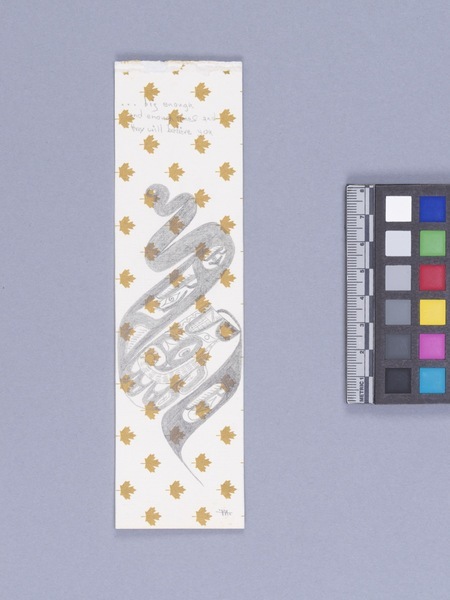Drawing Item Number: 3223/40 from the MOA: University of British Columbia


Description
A drawing on a bookmark; the bookmark is comprised of two pages attached together at the top with an adhesive. On the front of the top bookmark, a background of horizontally oriented maple leaves is printed in gold ink. The front is decorated with a vertically oriented, hand-drawn image of an inverted lightning serpent(?); there are two creatures drawn in the interior of the serpent's body. A lightning bolt(?), with an interior creature extends from the lightning serpent's mouth towards the bottom of the bookmark. At the top there are three lines of handwritten text. At the bottom of the front bookmark is the artist's signature, a "M" with a line through it and two dots. The interior-side of the top bookmark is blank. The bottom bookmark is a machine-printed image of the Prince of Wales Hotel in Waterton Lakes National Park; a tree is in the centre of the image, to the right the hotel is aglow, and a body of water is in the background. On the interior of the bottom bookmark, three lines from the anthem "O Canada!" are printed along the vertical plane.
History Of Use
These 62 small works (3223/1-62) comprise a collection of drawings in pencil, ink, pencil crayon, and felt pen made by the artist between the years 1968 and 2015. During that period the artist has identified himself by the following names: Ron Hamilton; Hupquatchew; Ki-ke-in; Kwayatsapalth; Chuuchkamalthnii; and Haa’yuups. The drawings are, for the most part, applied to the backs of bookmarks acquired from a range of bookshops; some are applied to other pieces of paper or cutouts from his earlier silkscreen prints. Many of the images represent killer whales, often in conjunction with accoutrements and symbols of Nuu-chah-nulth whaling. The juxtaposition of bookmark and representation of Nuu-chah-nulth himwits’a, or narrative, is a deliberate and meaningful placement of two distinct knowledge systems in relationship with one another. Ephemeral drawings like these were not created for the market; the artist has long made them for himself and sometimes as gifts for relatives and friends; they are a way of sharing his knowledge and experience about Nuu-chah-nulth ways of knowing, thinking about, and being in this world; they are expressive of what he calls kiitskiitsa: marks made with intention.
Item History
- Made by Ron Hamilton (Maker) in British Columbia, Canada between 1968 and 2015
- Owned by Ron Hamilton before November 8, 2016
- Received from Museum of Anthropology Acquisitions Budget (Funding source), Michael O'Brian Family Foundation (Funding source) and Ron Hamilton (Seller) on November 18, 2016
What
- Name
- Drawing
- Identification Number
- 3223/40
- Type of Item
- drawing
- Overall
- height 17.4 cm, width 4.8 cm
Who
- Culture
- Nuu-chah-nulth: Hupacasath
- Creator
- Ron Hamilton (Maker)
- Previous Owner
- Ron Hamilton
- Received from
- Museum of Anthropology Acquisitions Budget (Funding source), Michael O'Brian Family Foundation (Funding source) and Ron Hamilton (Seller)
Where
- Holding Institution
- MOA: University of British Columbia
- Made in
- British Columbia, Canada
When
- Creation Date
- between 1968 and 2015
- Ownership Date
- before November 8, 2016
- Acquisition Date
- on November 18, 2016
Other
- Item Classes
- works on paper
- Condition
- fair
- Current Location
- Case 9
- Accession Number
- 3223/0040